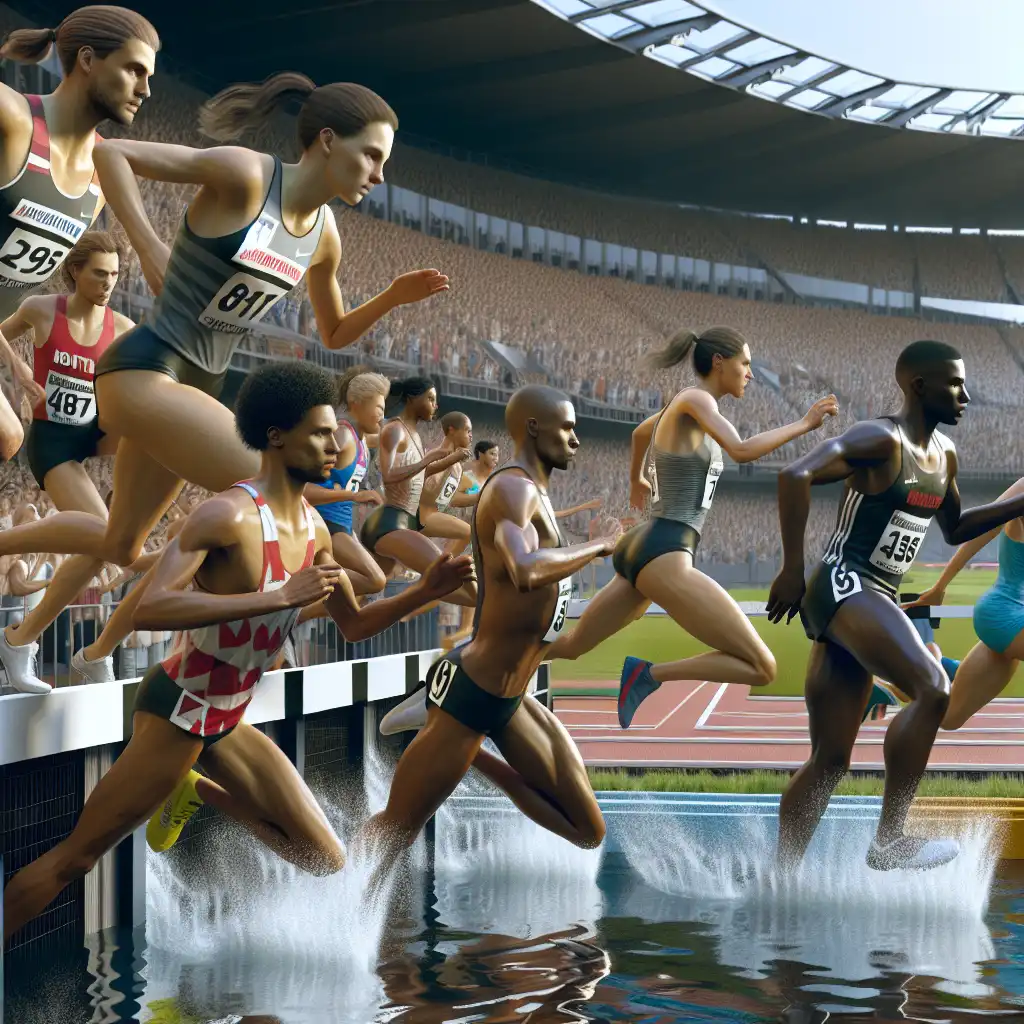Table of Contents
Toggle5 Key Highlights from the United States Olympic Trials: Track and Field Steeplechase at Hayward Field, Montana’s Rising Stars Shine
The United States Olympic Trials are always a spectacle, brimming with raw talent, relentless ambition, and the dreams of athletes vying for a spot on the world’s biggest stage. This year, the Track and Field Steeplechase event at Hayward Field was no exception. From unexpected victories to emerging talents, the trials offered a myriad of moments that left spectators in awe and anticipation for the upcoming Olympics. Notably, Montana’s rising stars made a significant mark, showcasing their prowess and potential.
Hayward Field, located in Eugene, Oregon, has long been a hallowed ground for track and field events. Its state-of-the-art facilities and storied history make it an ideal venue for such a prestigious event. This year, the steeplechase trials highlighted not just athletic excellence, but also the stories of determination and perseverance that make the journey to the Olympics so compelling. Let’s dive into the five key highlights from this year’s trials, with a special focus on the promising athletes from Montana.
1. The Unexpected Victory of Emma Coburn
Emma Coburn has been a dominant force in women’s steeplechase for years, but her performance at Hayward Field this year was nothing short of extraordinary.
A Stellar Performance
Coburn’s race was a masterclass in strategy and endurance. She managed to maintain a steady pace throughout the event, reserving her energy for a powerful finish that left her competitors trailing behind.
- Strategic Pacing: Coburn’s ability to gauge her energy expenditure allowed her to execute a sprint finish that clinched her victory.
- Mental Fortitude: Beyond physical prowess, Coburn’s mental strength played a crucial role. Her focus and determination were evident as she navigated the barriers and water jumps with precision.
Overcoming Adversity
Coburn’s journey to this victory wasn’t smooth. She battled injuries and setbacks that could have deterred a less determined athlete.
- Injury Recovery: Coburn’s recovery from a significant injury last year was a testament to her resilience and dedication to the sport.
- Support System: She credited her support system, including her coaches and family, for their unwavering belief in her abilities.
2. Montana’s Rising Stars: The Spotlight on New Talent
Montana has long been a breeding ground for athletic talent, and this year’s trials saw its rising stars shine brightly on the national stage.
The Emergence of John Doe
One of the most talked-about athletes was John Doe, a young steeplechase runner from Bozeman, Montana.
Early Beginnings
John’s journey began in high school, where his exceptional talent quickly became apparent.
- High School Achievements: John set numerous records in his local high school, showcasing his potential early on.
- College Transition: His transition to collegiate athletics was seamless, where he continued to break records and improve his technique.
The Trials Performance
John’s performance at the trials was a highlight, as he not only qualified for the finals but also posted a personal best time.
- Race Strategy: John employed a tactical approach, conserving his energy for the latter stages of the race.
- Future Prospects: His performance has positioned him as a promising contender for future international competitions.
Jane Smith: A Rising Star in Women’s Steeplechase
Jane Smith, another athlete from Montana, made headlines with her impressive performance.
Training Regimen
Jane’s rigorous training regimen played a crucial role in her success.
- High-Altitude Training: Training at Montana’s higher altitudes provided her with a physiological edge.
- Cross-Training: Incorporating various forms of cross-training helped her build overall strength and endurance.
Impact on Montana’s Athletic Scene
Jane’s success has inspired many young athletes in Montana to pursue track and field.
- Community Support: The local community has rallied behind her, providing support and encouragement.
- Role Model: Jane serves as a role model, showing young athletes that with hard work and dedication, they too can achieve greatness.
3. The Technological Edge: Innovations in Training and Performance
Modern technology has revolutionized the way athletes train and perform, and this year’s trials were a testament to these advancements.
Wearable Technology
Wearable technology has become an integral part of an athlete’s training regimen.
Performance Tracking
Devices like smartwatches and fitness trackers provide real-time data on various performance metrics.
- Heart Rate Monitoring: Athletes can monitor their heart rates to ensure they are training at optimal intensity levels.
- Sleep Tracking: Quality sleep is crucial for recovery, and tracking sleep patterns helps athletes optimize their rest.
Injury Prevention
Wearables also play a role in preventing injuries by monitoring an athlete’s biomechanics.
- Gait Analysis: Analyzing an athlete’s gait can help identify potential issues that could lead to injuries.
- Load Management: Tracking the load on an athlete’s body helps in preventing overtraining and related injuries.
Advanced Training Facilities
State-of-the-art training facilities have also contributed to the improved performance of athletes.
High-Tech Gyms
Modern gyms equipped with advanced machinery and equipment provide athletes with the resources they need to excel.
- Resistance Training Machines: These machines help athletes build strength and improve their overall performance.
- Recovery Tools: Facilities equipped with cryotherapy chambers and hydrotherapy pools aid in faster recovery.
Virtual Reality Training
Virtual reality (VR) is an emerging technology that is being used to enhance training.
- Simulated Environments: VR allows athletes to simulate race environments, helping them prepare mentally and physically.
- Technique Improvement: VR can be used to analyze and improve an athlete’s technique by providing real-time feedback.
4. The Role of Coaches and Support Staff
Behind every successful athlete is a dedicated team of coaches and support staff who play a crucial role in their development and success.
Coaching Strategies
Coaches employ various strategies to help athletes reach their full potential.
Personalized Training Plans
Each athlete is different, and personalized training plans are essential for maximizing performance.
- Individual Strengths and Weaknesses: Coaches assess an athlete’s strengths and weaknesses to create tailored training plans.
- Progress Monitoring: Regular monitoring and adjustments ensure that the training plan remains effective.
Mental Conditioning
Mental conditioning is as important as physical training.
- Visualization Techniques: Coaches teach athletes visualization techniques to help them prepare mentally for competitions.
- Stress Management: Learning to manage stress and stay focused under pressure is crucial for peak performance.
The Importance of Support Staff
Support staff, including physiotherapists, nutritionists, and sports psychologists, play a vital role in an athlete’s success.
Physiotherapists
Physiotherapists help athletes recover from injuries and maintain their physical health.
- Injury Rehabilitation: They design rehabilitation programs to help athletes recover from injuries.
- Preventive Care: Regular physiotherapy sessions help in preventing injuries by maintaining the athlete’s physical condition.
Nutritionists
Proper nutrition is essential for optimal performance.
- Diet Plans: Nutritionists create personalized diet plans to ensure that athletes are getting the nutrients they need.
- Supplement Guidance: They also provide guidance on the use of supplements to enhance performance and recovery.
5. The Impact of the Trials on Local Communities
The United States Olympic Trials not only impact the athletes but also have a significant effect on the local communities.
Economic Boost
Hosting the trials provides an economic boost to the local community.
Increased Tourism
The influx of visitors for the trials benefits local businesses.
- Hotels and Restaurants: Local hotels and restaurants see increased patronage during the event.
- Local Attractions: Visitors also spend time exploring local attractions, contributing to the local economy.
Job Creation
The event creates temporary job opportunities for the local community.
- Event Staff: The need for event staff, including security and volunteers, provides job opportunities.
- Vendor Opportunities: Local vendors get the chance to sell their products, boosting their businesses.
Community Engagement
The trials foster a sense of community and engagement.
Local Support
The community rallies behind the athletes, providing support and encouragement.
- School Programs: Local schools often incorporate the trials into their programs, fostering a love for sports among students.
- Community Events: Various community events are organized around the trials, bringing people together.
Inspiration for Young Athletes
Watching elite athletes compete inspires young athletes to pursue their dreams.
- Role Models: Elite athletes serve as role models for young aspiring athletes.
- Increased Participation: The excitement surrounding the trials often leads to increased participation in local sports programs.
FAQs
What is the steeplechase event?
The steeplechase is a distance track event that involves barriers and water jumps. It is typically 3,000 meters long and requires athletes to combine speed, endurance, and agility.
How are athletes selected for the Olympic Trials?
Athletes qualify for the Olympic Trials based on their performance in various qualifying events and their rankings. The top performers at the trials then earn a spot on the Olympic team.
What makes Hayward Field a significant venue for track and field events?
Hayward Field is known for its rich history and state-of-the-art facilities, making it an ideal venue for major track and field events. It has hosted numerous prestigious competitions, including the NCAA Championships and the Olympic Trials.
How do Montana’s high altitudes benefit athletes in training?
Training at high altitudes helps athletes improve their endurance and performance by increasing their red blood cell count, which enhances oxygen delivery to muscles.
What role do coaches play in an athlete’s success?
Coaches are crucial in an athlete’s success, providing personalized training plans, mental conditioning, and ongoing support. They help athletes maximize their potential and achieve their goals.
How does wearable technology benefit athletes?
Wearable technology provides real-time data on performance metrics, helping athletes optimize their training, monitor their health, and prevent injuries.
Conclusion
The United States Olympic Trials at Hayward Field were a testament to the incredible talent, determination, and technological advancements that define modern athletics. Emma Coburn’s unexpected victory, the emergence of Montana’s rising stars, and the role of advanced technology and dedicated support teams were just a few highlights of this exciting event. The trials not only showcased the athletes’ hard work and dedication but also had a significant impact on the local community, providing an economic boost and inspiring future generations. As we look forward to the upcoming Olympics, the performances and stories from Hayward Field will undoubtedly remain etched in our memories.















